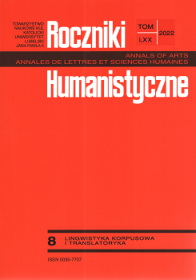Wypowiedzi definicyjne bezpośrednie w języku francuskim oraz ich litewskie i polskie odpowiedniki w korpusie paralelnym
Abstrakt
Artykuł dotyczy wypowiedzi definicyjnych w języku francuskim ze znacznikami désigner, signifier, vouloir dire i c’est-à-dire. Dane językowe pochodzą z korpusu paralelnego współczesnych tekstów literackich francusko-litewsko-polskich. Analiza skupiona będzie na litewskich i polskich ekwiwalentach wybranych znaczników. Jej celem będzie stwierdzenie: (1) jakie są owe ekwiwalenty w obu językach docelowych oraz (2) czy istnieją prawidłowości w tłumaczeniu wypowiedzi z analizowanymi znacznikami.
W przypadku désigner, tłumaczenia na język polski i litewski zachowują charakter wypowiedzi definicyjnej, w której wyrażana jest relacja znak→obiekt. Relacja interpretacyjna wypowiedzi definicyjnych z signifier i vouloir dire jest również w większości zachowana w tłumaczeniu. Natomiast charakter parafrazy w przypadku c’est-à-dire jest zachowany w języku polskim jedynie w 3 przypadkach na 19 dzięki partykule czyli. W języku litewskim relacja ta utrzymana jest w 11 wypowiedziach dzięki znacznikom tai yra i kitaip tariant.
Bibliografia
Altenberg, Bengt, & Sylviane Granger. Lexis in Contrast. Corpus-based approaches. Benjamins, 2002.
Auger, Alain. Repérage des énoncés d’intérêt définitoire dans les bases de données textuelles, thèse de doctorat, Université de Neuchâtel, 1997.
Johansson, Stig. « Seeing through multilingual corpora. » Corpus Linguistics 25 Years On, éd. Roberta Facchinetti, Rodopi, 2007, pp. 51-71.
Gosselin, Laurent. Temporalité et modalité en français. Duculot, 2005.
Guidère, Mathieu. Introduction à la traductologie : penser la traduction : hier, aujourd’hui, demain. De Boeck–Duculot, 2011.
Mortureux, Marie-Françoise. « Paraphrase et métalangue dans le dialogue de vulgarisation ». Langue française, 53, 1982, pp. 48-81.
Murât, Michel, & Bernard Cartier-Bresson. « C'est-à-dire ou la reprise interprétative ». Langue française, 73, 1987, pp. 5-15.
Nádorníková, Olga. « Pièges méthodologiques des corpus parallèles et comment les éviter ». Corela». HS-21, 2017, journals.openedition.org/corela/4810. DOI : 10.4000/corela. 4810. Consulté 30.04.2021.
Rebeyrolle, Josette. Forme et fonction de la définition en discours. Université Toulouse II, Thèse de Doctorat Nouveau Régime, 2000.
Rebeyrolle, Josette, & Ludovic Tanguy. « Repérage automatique de structures linguistiques en corpus : le cas des énoncés définitoires ». Cahiers de Grammaire, 25, 2000, pp. 153-174.
Rey-Debove, Josette. Étude linguistique et sémiotique des dictionnaires français contemporains. Mouton, 1971.
Riegel, Martin. « Définition directe et indirecte dans le langage ordinaire : les énoncés définitoires copulatifs ». Langue française, 73, 1987, pp. 29-53.
Riegel, Martin. « La définition, acte du langage ordinaire – De la forme aux interprétations ». La définition, éd. Jacques Chaurand & Francine Mazière, Larousse, 1990, pp. 97-110.
Rossari, Corinne. Les opérations de reformulation. Analyse du processus et des marques dans une perspective contrastive français-italien. Peter Lang, 1994.
Wimmer, Christine. « L’explication de la relation signe-signifié dans le discours non lexicographique ». Langue française, 73, 1987, pp. 54-75.
Copyright (c) 2022 Roczniki Humanistyczne

Utwór dostępny jest na licencji Creative Commons Uznanie autorstwa – Użycie niekomercyjne – Bez utworów zależnych 4.0 Międzynarodowe.





